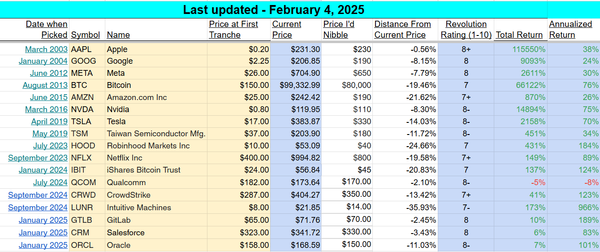Trade Alert – Everything you need to know about Intel and the chip industry
Let’s talk about a developing tech story that will be the single most important driver of Intel and many other semiconductor stocks for the next few years.
First, let’s back up and talk about what Intel’s chips do and why the company is so important to the industry’s dynamics. There are many commoditized chip makers who churn out single-purpose chips for cars, refrigerators, set-top boxes, wi-fi, radios, and so on. Those kinds of chips, while incredible all the same, are commoditized because it’s not hard to set up a company, hire a few engineers, subcontract out the manufacturing of the chips to a giant chip factor company in Asia, get some distribution and viola, you got a chip company. Intel, Arm Holdings, Qualcomm, AMD, Samsung and a few other companies play in a much higher margin business of making much smarter chips that enable computers and smartphones and tablets to do all the widely disparate, wildly innovative things they do. They call these chips “central processing units” or CPUs because they, like a human being’s central nervous system, are able to be adapted to many different functions and applications.
We’ve seen a few companies over the years try to build a CPU business from the ground up, but the cost of making these chips, because you typically can’t just subcontract out such a highly technically difficult manufacturing process, is huge. Especially the up front costs. Intel spends $10-15 billion a year on the equipment to make their chips. Samsung too.
Meanwhile, companies like ARM Holdings design chip architecture that companies like Qualcomm use to design their own smartphone/tablet chips which are then manufactured by Taiwan Semiconductor (which spends $5-10 billion a year on building factories and new chip fab equipment).
For the last few years, Intel’s been far behind the curve in the amount of deep thoughts that their smartphone/tablet brains can put out per calorie they take in. That is, their power consumption has been way too high for the amount of processing power their chips are capable of providing. That has resulted in, according to IDC and other industry analysts, Qualcomm got 50% market share in smartphone application processor market 86% market share (which is about like Intel’s own market share in PCs) in LTE cellphone modems.
Flipping that on its head then, if Intel can crack into the smartphone/tablet market with a cheaper, more efficient CPU than the ARM Holdings licensees like Qualcomm specifically can, then Intel’s got almost the entire smartphone/tablet market to take share in. We’re talking about hundreds of millions of CPU chips of which Intel’s currently got nearly no marketshare.
And guess what? In a press event yesterday, Intel claimed that their new Silvermont CPU microarchitecture for smartphones/tablets delivers about three times more peak performance, or the same performance at about 20% of the power consumption, of today’s smarpthone/tablet chips.
Meanwhile, Intel’s been left for dead because the company’s PC market is struggling so badly against the aforementioned smartphone/tablet market. The stock is trading at 10x next year’s earnings, net cash and yielding 4%. There’s a very long-term floor around $20 a share. And here’s the deal. If Intel can take even just 5-10% marketshare in the high-end smartphone/tablet industry, the current analyst earnings estimates for 2015 or 2016 will end up being way too low. I’d expect the stock to run near $40 a share if the company finally starts to catch up in the smartphone/tablet chip industry.
I am personally going to add to my Intel common stock shares here and if the stock does happen to drop back near its floor at $20 a share anytime this year, I’ll likely get very aggressive in building up this position in my personal portfolio.




